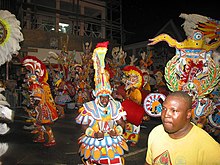Music of the Bahamas
| Music of the Anglophone Caribbean | ||||
| Genres | ||||
|---|---|---|---|---|
|
|
||||
|
|
||||
| Regional music | ||||
|
||||
The music of the Bahamas is associated primarily with
Calypso
Calypso is a style of Afro-Caribbean music which originated in Trinidad and Tobago. This form of music has spread through many parts of the Caribbean, including The Bahamas.
Soca
Soca is a form of dance music which originated from many calypso music in Trinidad and Tobago. It originally combined the melodic lilting sound of calypso with insistent percussion (which is often electronic in recent music) and local chutney music. Soca music has evolved in the last 20 years primarily by musicians from various Anglophone Caribbean countries including Trinidad, Guyana, Saint Vincent and the Grenadines, Barbados, Grenada, Saint Lucia, Antigua and Barbuda, United States Virgin Islands, The Bahamas, Dominica, Saint Kitts and Nevis, Jamaica and Belize.
Junkanoo

The word Junkanoo is said to be derived from a

In 1973, the year the Bahamas achieved independence from the United Kingdom, black professionals of the middle and upper classes began to dominate junkanoo celebrations. Costuming and competitions became more complex and commonplace, and soon became a tourist draw.
Aside from being a type of drum,
Rake and scrape
Organology of instruments
Membranophones: The Goombay drum is the main rhythmic component in rake-n-scrape. It is also referred to a goatskin drum, as the skin of a goat was stretched over a wooden barrel. It is decorated by simple or complex geometric designs in bright colors. The drum is always heated over fire to retain its tone. In 1971, when manufacturers started shipping products in metal barrels, Bahamians switched the drum to metal, slightly changing the tone of the drum.[3]
Idiophones: The main component that makes Rake-N-Scrape unique is the use of the Carpenter's Saw. This instrument is scraped with a nail or butter knife. Bent against the body of the player and flexed, various timbral effects are obtained.[4] In more modern music, the saw is replaced with maracas or a guiro.[5]
Aerophones: The accordion is the component that adds the round form which enables dancers to dance the ring dance. This is of European descent. In more modern bands, it is replaced by an electric guitar or electronic keyboard.[6]
See also
References
- ISBN 9780520265684.
- ^ "Music of The Bahamas - Rake 'n' Scrape". www.bahamasentertainers.com. Archived from the original on 13 August 2006.
- ^ Ingraham 368
- ^ Ingraham 369
- ^ Rommen 173
- ^ Ingraham 369
- Kaliss, Jeff. "Junkanoo and Sloop John B.". 2000. In Broughton, Simon and Ellingham, Mark with McConnachie, James and Duane, Orla (Ed.), World Music, Vol. 2: Latin & North America, Caribbean, India, Asia and Pacific, pp 317–324. Rough Guides Ltd, Penguin Books. ISBN 1-85828-636-0
- Rommen, Timothy. "Come Back Home: Regional Travels, Global Encounters, and Local Nostalgias in Bahamian Popular Musics." Project Muse: Latin American Music Review, Vol 30, Number 2, Fall/Winter 2009. University of Texas Press, 159–183.
- Ingraham, Veronica. 2007. "The Bahamas" in An Encyclopedic History: Music in Latin America and the Caribbean, vol. 2, Performing the Caribbean Experience, Ed. By Malena Kuss. Texas: University of Texas Press, 359–376.
- http://www.bahamasentertainers.com/
- The Bahamas: Islands of song, recorded and produced by Oete Reiniger, with introductory essays by Gail Saunders and Kayla Olubumni Lockhart Edwards. I CD, Smithsonian Folkways SF 40405 (1997).
External links
- (in French) Audio clips: traditional music of the Bahamas. Musée d'ethnographie de Genève. Accessed 25 November 2010.
- "Drive the Nail A'Right, Boys." (Downloadable recording) Bahamanian conch song. Library of Congress, Florida Folklife from the WPA Collections; performed by Naomi Nelson on 15 January 1940 in Riviera, Florida. Accessed 10 September 2010.

